The retail world has a major bot problem. During popular drops, up to 97% of online traffic comes from bad bots operated by scalpers. In this article, you’ll discover behind-the-scenes drop data that reveals just how much retail traffic is malicious, and just how effective Queue-it’s invite-only waiting room is at stopping that traffic in its tracks.
Product drops and loyalty programs are among the top trends shaping how online retailers attract and retain customers.
Product drops are the hype and headline generating machines that get loyal customers excited and bring new customers into the fold. And loyalty programs help companies capture data and nurture long-term customer relationships.
These two major ecommerce trends converge via a single strategy: exclusive access.
91% of the best U.S. apparel loyalty programs offer early or exclusive access to sales & new products.
Other surveys show exclusive access is the #1 most desirable benefit of a loyalty program after savings-based benefits like free shipping and discounts.
But exclusive access can be tough to get right. When popular products can be resold for profit, scalpers swoop in with bots to snatch up inventory from genuine customers. Members are left empty-handed and angry, turning your hyped drop into a major flop.
In this article, you’ll discover how a household-name gaming company used the invite-only waiting room—Queue-it’s exclusive access tool—to block over 700,000 bots across 4 exclusive product drops, grow their loyalty program memberships by 40%, and ensure fair and smooth product drop access for 170,000 loyal members.
23% of all retail web traffic in 2022 came from bad bots. During popular product drops and Holiday Season sales, we’ve seen this number jump to up to 97%.
Bot traffic surges during product drops for two key reasons. First, there’s a lot of money to be made from scalping products, especially for limited-edition items and collectibles with high resale value. Second, the purchase limits companies often put in place to prevent scalping—such as one product per customer—encourage resellers to attack in huge volumes.
To get around purchase limits, scalpers will hit the site with hundreds or thousands of bots—all prepared to enter unique names, email addresses, and credit card information to mask their fraudulent behavior.
The more undetected bots a scalper can create, the more products they can buy, and the more profit they can make.
If a scalper successfully gets 1,000 bots onto your product page, for example, they can turn “one purchase per customer” into 1,000 purchases just for themselves.
So while genuine demand for your drops may be massive, there’s often more to the numbers than meets the eye.
Earlier this year, a household-name gaming company used Queue-it’s invite-only waiting room on a series of limited-edition product drops. In this section, you’ll get a behind-the-scenes deep-dive into one of these drops. In the next section, we’ll look at traffic across the 4 drops.
First, let’s look at what the actual waiting room for the drop looked like. During the first hour, 7,000 invited and verified users entered the waiting room.
Across the next 23 hours, another 21,000 verified visitors entered the queue, meaning a total of 28,000 people got a spot in line for the drop.
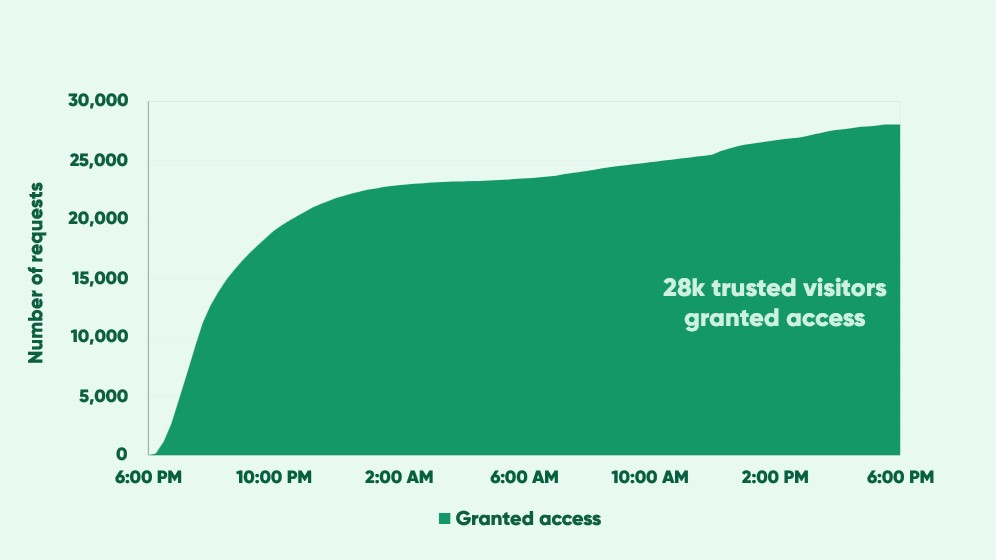
But the number of requests to enter the queue was much higher than 28,000—14 times higher, to be exact.
Behind-the-scenes of the smooth and fast product drop experience of the loyalty program members, there were swarms of retail bots fighting to get access to the drop, fighting to get their hands on the valuable products.
If we zoom out on the chart above to include these bots and visitors that were denied access, the picture becomes quite different.
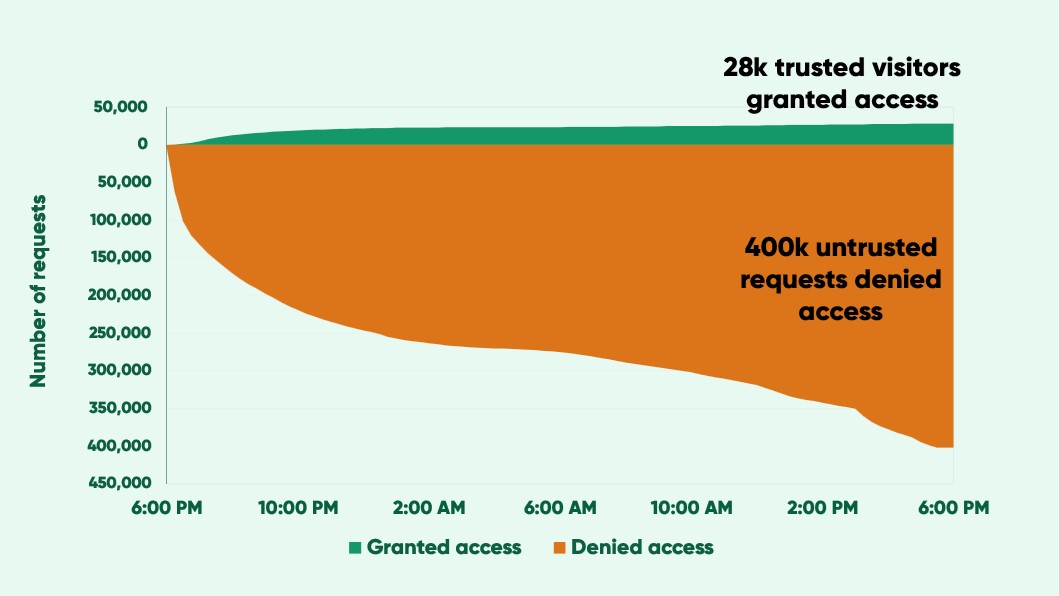
The number of untrusted requests to enter the queue—meaning bot traffic and/or visitors that weren’t invited to the drop—dwarfs the number of trusted visitors who played by the rules.
In the first hour of the drop, there were over 130,000 untrusted requests to enter the drop. Within 24 hours, over 400,000 attempts from untrusted visitors were denied access.
Over 94% of the total traffic to the drop was untrusted requests from bots, scalpers, and uninvited users.
But with Queue-it in place, these 400,000 requests were denied access, meaning the 28,000 trusted, verified customers got a dramatically fairer and faster drop experience.
RELATED: Everything You Need To Know About Preventing Online Shopping Bots
The gaming company who ran this hyped drop had two key goals.
First, they wanted to ensure that bots and resellers wouldn’t swarm the sale, causing complaints or crashing the website.
Second, they wanted to reward their loyalty program members and incentivize sign-ups among non-members.
With Queue-it’s invite-only waiting room, they achieved both.
The drop was available exclusively to their 100,000 loyalty members—almost 30% of whom participated. The company sent out private invitations containing unique links that offered each trusted member one spot in line.
So when access was denied, it meant either:
- A trusted visitor was trying to use their link to take multiple spots in queue, or;
- An untrusted visitor was trying to access the onsale without an invitation
You can see in the chart below how scalpers try to attack in volume. They find the product page or get their hands on one unique link and try to open it on hundreds or thousands of virtual computers.
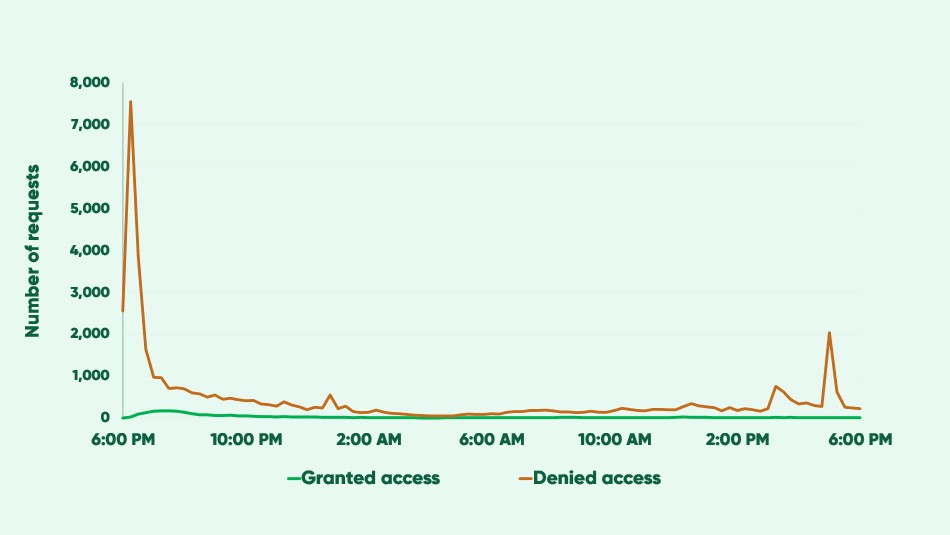
The trusted traffic increases steadily when the sale opens, peaking early on at around 170 visitors per minute. Meanwhile, the untrusted traffic spikes suddenly and dramatically when the sale opens, peaking at 7,500 in a single minute.
This is clear non-human behavior. It represents one or several scalpers trying to access the product page hundreds or thousands of times.
But despite their tireless efforts, the invite-only waiting room ensured only trusted loyalty program members could get access. And even for the scalpers who signed up for the loyalty program, it guaranteed each person could only get one spot in line and walk away with max one product.
While the resellers made futile attempts to get into the sale and snatch up products, the gaming company delivered:
- A fairer experience for almost 30,000 verified members
- Dramatically shorter wait times
- A 94% reduction in traffic load
- A drop experience that gave both customers and the media nothing negative to write about
After a successful first drop with the invite-only waiting room, the tool became the standard for how the gaming company runs its most hyped releases.
In the three months since the first drop, they’ve run three more exclusive access drops using the waiting room. And with each drop, their membership base has grown.
The drop we explored above had just over 103,000 invited members. Less than four months later, they invited 140,000 members to their drop.
With the promise of exclusive access, the gaming company’s loyalty program base grew by almost 40% in four months.
But even though their loyalty base grew, untrusted visitors and bots continued to exceed members in all four drops.
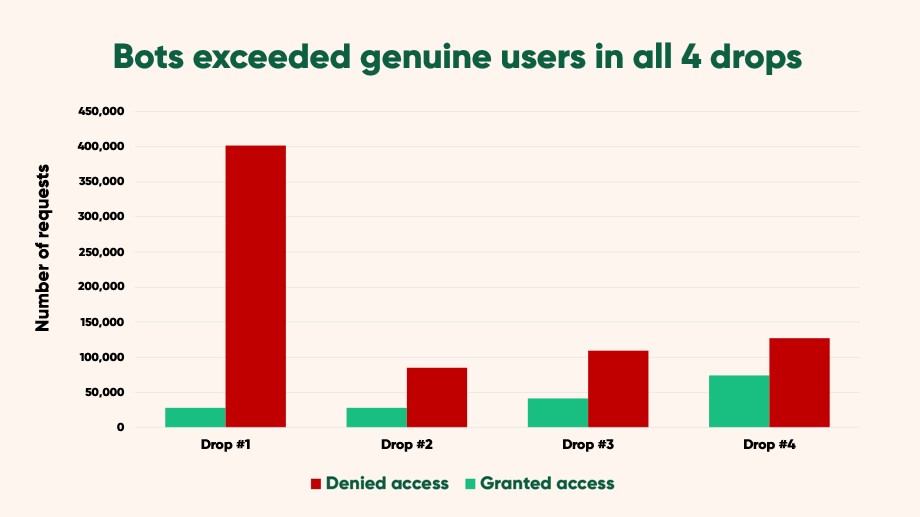
Queue-it’s invite-only waiting room lets you control access to exclusive sales. Think of it like a security guard for your sale, controlling the inflow of people and checking IDs to ensure only invited customers can enter.
The idea of exclusive access is not a new one. Many retail companies distribute links to their drops exclusively to members or newsletter subscribers. Others require customers to login or create an account to purchase products.
But an invite-only waiting room adds a new level of protection and control. Rather than sending out a standard link that can be shared and accessed by all, the invite-only waiting room uses unique, single-use links. And rather than verifying customers at the end of the purchase path or at the login (once they’ve already hit your site), it gates access to the entire product page.
Only customers you choose can queue for products, enter the sale, add them to the cart, and eventually checkout.
In the drop example above, the gaming company used their loyalty program membership to determine the trusted customers they wanted to invite to the sale.
They then set up the invite-only waiting room, uploaded a mailing list with the details of their trusted customers, and sent out invitations to the drop.
Members opened their invitation, Queue-it verified they were on the invite list, and they were then granted access to the waiting room for the drop.
Scalpers tried to do what they always try to do: get more products by getting more spots in line.
But as we saw from the scalpers who hit the sale in volumes of 7,000+ per minute, all any of them got was one spot in line, maybe one product, and a whole lot of wasted computing power.
For the 4 invite-only drops we helped this top gaming company run, the story was the same:
- 723,000 requests were denied access with the invite-only waiting room
- 173,000 verified members got a fairer experience
- Queue wait times were dramatically shorter
- The company more than halved the load on their infrastructure
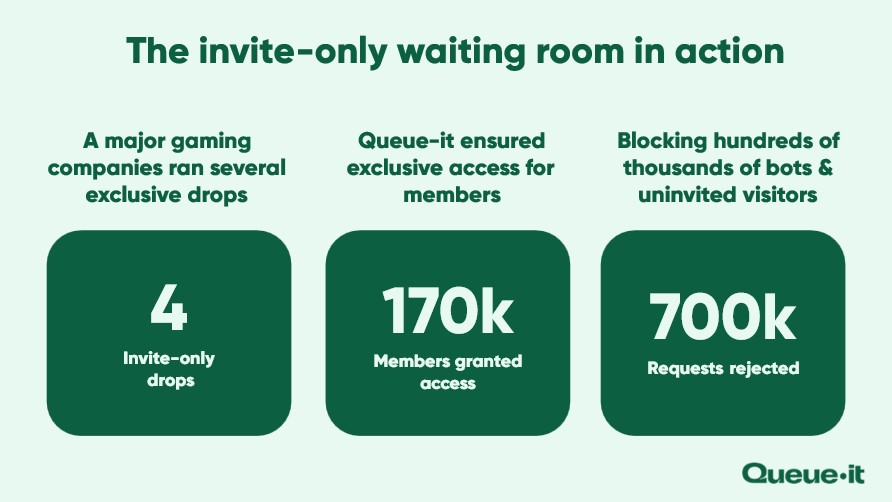
With the help of the invite-only waiting room, this top gaming company rewarded loyal members and grew their membership base—all while blocking over 700,000 bots and scalpers.




